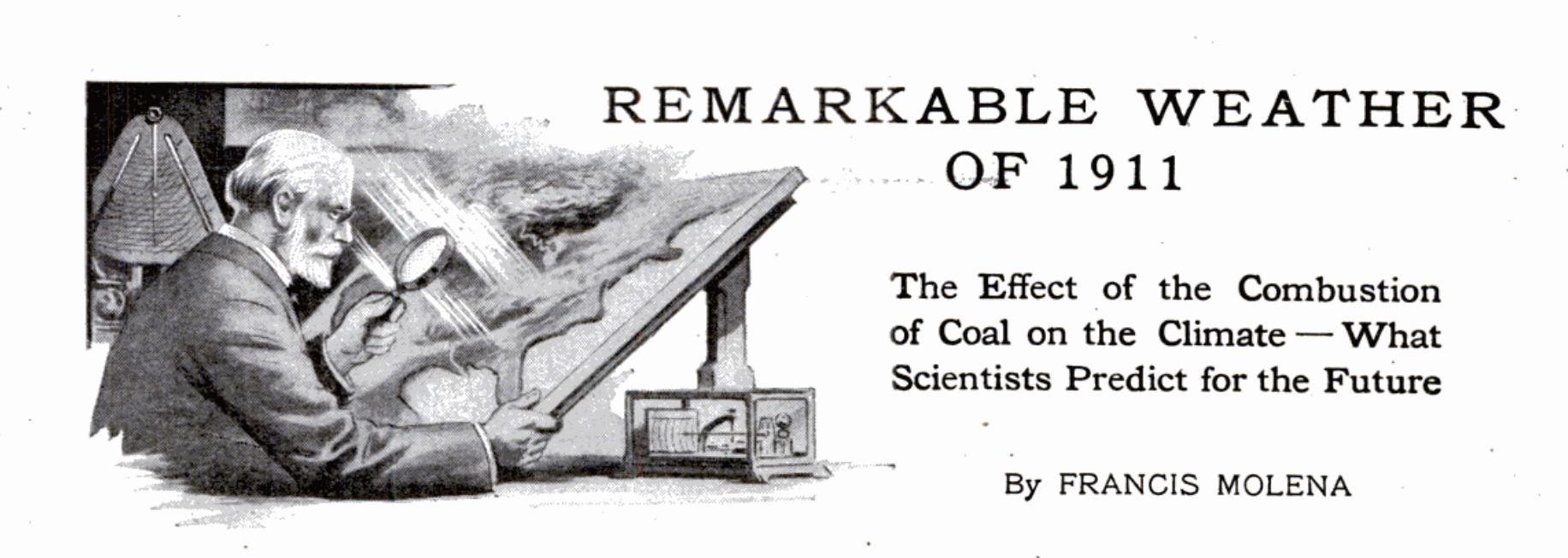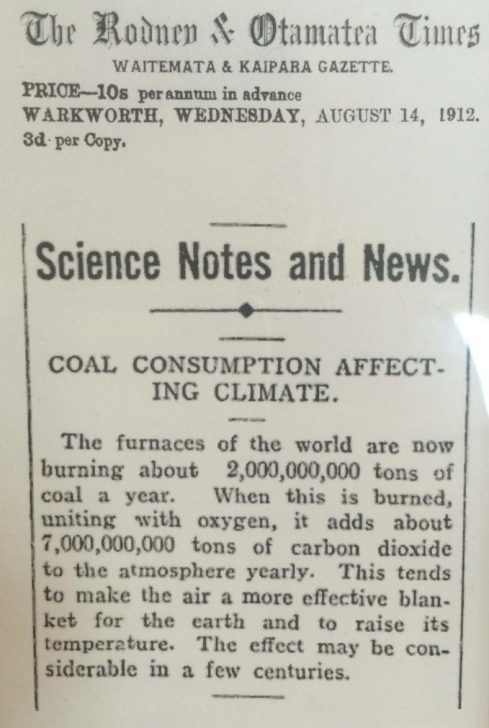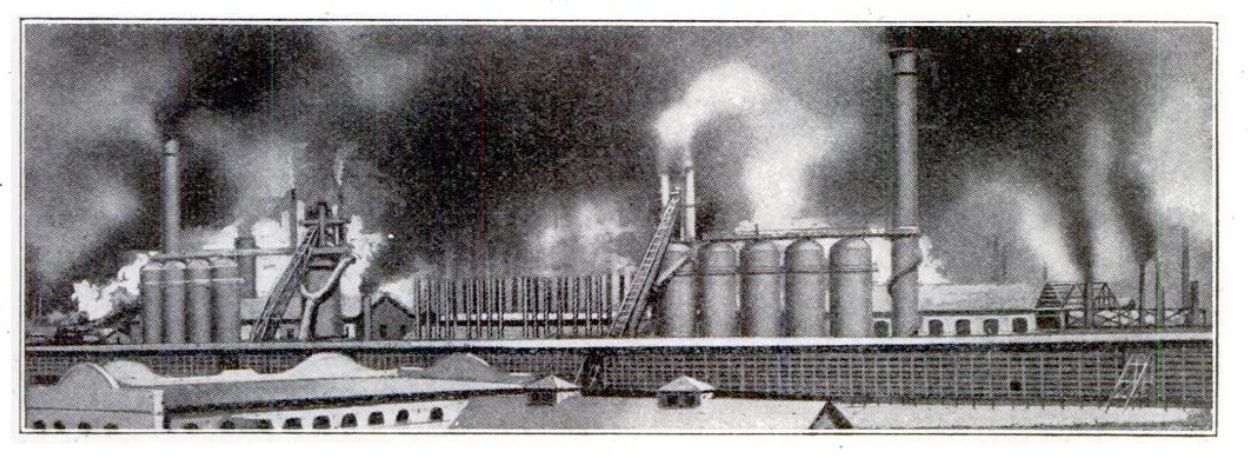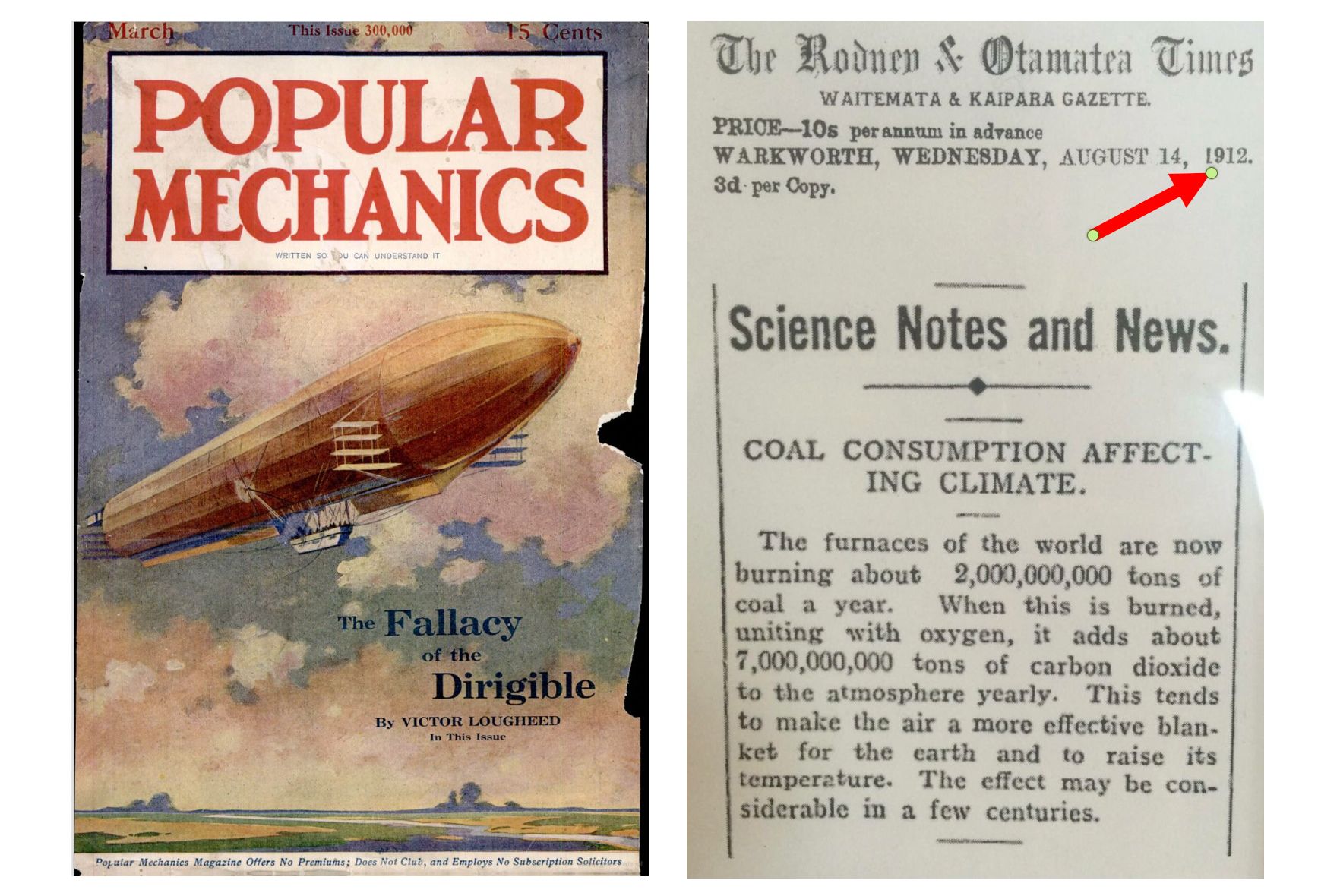Greenhouse Effect Known As Early as 1912
Check out the March 1912 issue of Popular Mechanics, p. 339, an article entitled “The Remarkable Weather of 1911.”
The subtitle summarizes the story: The Effect Of The Combustion of Coal on the Climate – What Scientists Predict For The Future.

The year 1911 will long be remembered for the violence of its weather. The spring opened mild and delightful, but in June a torrid wave of unparalleled severity swept over the country. The cities baked and gasped for breath, while the burning sun and hot winds withered the corn and cost the farmers a million dollars a day. A little later England was scorched and France and Germany sweltered. The mercury went above 100 degrees in western Canada, and whalers brought back reports from the Arctic regions of open water where always before there had been solid ice. The reports from Mexico and Central America would well describe the lower regions, but it is said that the summer in Iceland was enjoyable.

In August the elements took a different turn and the flood-gates of the heavens were opened. Kentucky and the South Atlantic states were deluged, and the Philippines were more thoroughly drowned than they had been before since the time of Noah. Alberta was visited by a killing frost which ruined hundreds of pioneer farmers. A cyclone devastated Costa Rica and a violent gale swept the South Atlantic coast, destroying a great number of vessels. During the later fall, the North Atlantic was tormented by a series of more violent storms than were known to the oldest sea captains. In November the southern states were visited by a killing frost, while December was remarkable for its high temperatures.
Aside from the extreme heat, the frosts of the far North and the sunny South, and the violent storms at sea, the year 1911 was still exceptional. The mean temperature of every month except November was above the average of that of the 40 years covered by the records of the United States Weather Bureau. The average daily excess was from four to six degrees.
With only one month out of twelve below normal, one may well ask if the climate is not changing and getting warmer. There is a general impression among older men that the good old-fashioned winters in which “the snow was fifteen feet deep and lasted six months” do not come anymore. In spite of the fact that the year just past was above the average in temperature, there is no clear indication that there is any progressive change in the direction of a warmer climate. The average temperature of the year 1878 was as high as that of 1911. There seem to be moderate changes in a cycle of about 35 years, and it is suggested that this is related to the period of sun-spot activities, which is about one-third as long.
It has recently been found by archeologists from their studies in Asia Minor that, during the thousands of years these semiarid countries have been inhabited by civilized men, their populations have increased and decreased with a period of two or three hundred years. It is supposed that the epochs of greatest population were when there was more than the normal amount of rainfall, so that more people than ordinarily could be supported. When the oscillation in climate changed toward a dry period, so that food became scarce, the population necessarily decreased, though the changes might be ascribed in some instances to other causes. The climatic explanation of these variations in population seems most reasonable.

But it is not necessary to refer to the history of mankind in order to prove that the earth has undergone much greater changes in climate than those we are now experiencing. The deposits of salt and gypsum which are found in New York and Michigan are the beds of ancient seas which dried up when these regions were deserts; on the other hand, arid Arizona was once watered with abundant rains. as is shown by the petrified remains of enormous trees which hundreds of thousands of years ago grew in that region. In frozen Greenland, the fossil remains of magnolias and other semitropical plants are found; while at the other end of the earth, near the south pole, there are beds of coal formed from vegetation which flourished when that region had a temperate climate.
On the other hand, time after time, great sheets of ice have pushed down from the tablelands of Canada through the valleys of the Great Lakes, over the prairies and across the hills, and have reached as far south as the Ohio and the Missouri Rivers. The records written on the hillsides by these slowly moving glaciers, and the heaps of soil and rounded boulders where they have stopped and melted, prove that at least seven times this country. has been buried beneath the snow and ice. At other times, still earlier in the history of the world, there have been glaciers at moderate altitudes on both sides of the equator, well within the tropical zone. It is difficult to determine with any high degree of accuracy how long it has been since the last glacial epoch, but fifty or a hundred thousand years have passed since the ice sheets covered this region.
If the earth has undergone such remarkable changes in temperature and has experienced such extremes of drought and moisture, it may be asked what the prospects are for the future. It may be answered immediately that these climatic variations are so slow and that these cycles are so vast, that there is no prospect of any material change in the lifetime of a single individual, or even of a nation. It is highly improbable that the mean temperature will change sensibly in a thousand years, and very probable that it will not be much different from what it is at present ten thousand years from now. But if we may judge the future from the past, we may conclude that extremes of cold and warmth will succeed each other in long cycles measured by tens of thousands or hundreds of thousands of years; for there is no more reason now to suppose that conditions will henceforth be fixed or even steadily progressive in one direction than there would have been to have made the supposition at the corresponding stage in any previous cycle. There are indications that the maximum of the warm era in which we now live has not yet been reached and that, therefore, the climate will probably become slowly warmer for some thousands of years, this progression being broken by many small oscillations. After the maximum is past the climate will, on the whole, probably steadily become colder until another ice age follows.

The causes of the changes are about as interesting as the changes themselves, and if they are known it may be questioned whether we cannot control the climate in the future. While the heat which warms the earth comes from the sun, the climate is fundamentally dependent upon the earth’s atmosphere and upon its circulation. It screens off the heat somewhat in the daytime and holds it in at night. The winds carry vast quantities from the torrid equator to the higher latitudes, and freshen the equatorial zone with the cooler atmosphere from the polar regions. The absorption and screening properties of the atmosphere depend upon its constitution. It has been found that if the air contained more carbon dioxide, which is the product of the combustion of coal or vegetable material, the temperature would be somewhat higher. In fact, a theory has been elaborated, primarily by the great Swedish scientist Arrhenius, that the earth has had a warm climate when the amount of carbon dioxide in the air was abundant, and a cold climate when it was scarce. It is believed that if the atmosphere contained two or three times its present amount, the climate would be considerably warmer, and that if it should lose half of that which it now has, the glaciers would again form in Canada. There are good reasons for believing that the quantity of this gas in the atmosphere may slowly undergo variations.
Since burning coal produces carbon dioxide it may be inquired whether the enormous use of that fuel in modern times may not be an important factor in filling the atmosphere with this substance, and consequently in indirectly raising the temperature of the earth. In the United States about 500,000,000 tons of coal were mined in 1911. Suppose four times this amount were mined and burned in the whole world. When this amount of coal is burned, 7,000,000,000 tons of carbon dioxide are put into the atmosphere. The question is, simply, whether this is an appreciable fraction of that which the atmosphere already holds, and whether there are any important ways in which it is being removed from the atmosphere.
The atmosphere contains altogether 1,500,000,000,000 tons of carbon dioxide. Consequently, the combustion of coal at the present rate will double it in about 200 years, unless it is removed by some means in enormous quantities. Carbon dioxide is removed from the atmosphere by growing plants, and in fact the carbon in the coal came from the air through the vegetable matter from which it has been formed. But when vegetable matter is burned, or decays, or is consumed by animals, the carbon dioxide is returned to the atmosphere. It does not seem that there will be in this way any great gain or loss in the next few centuries. A more important factor is the oceans which now hold enormous quantities of carbon dioxide and which, under suitable conditions, can absorb much more. In fact, they are the great regulators and have been involved essentially in all the variations of the past. But the action of the sea is very slow, and it may well be that the enormous present-day combustion of coal is producing carbon dioxide so fast that it will have important climatic effects.

It is perhaps somewhat hazardous to make conjectures for centuries yet to come, but in the light of all that is known it is reasonable to conclude that not only has the brain of man contrived machines by means of which he can travel faster than the wind, navigate the ocean depths, fly above the clouds, and do the work of a hundred, but also that indirectly by these very things, which change the constitution of the atmosphere, have his activities reached beyond the near at hand and the immediate present and modified the cosmic processes themselves. It is largely the courageous, enterprising, and ingenious American whose brains are changing the world. Yet even the dull foreigner, who burrows in the earth by the faint gleam of his miner’s lamp, not only supports his family and helps to feed the consuming furnaces of modern industry, but by his toil in the dirt and darkness adds to the carbon dioxide in the earth’s atmosphere so that men in generations to come shall enjoy milder breezes and live under sunnier skies.

